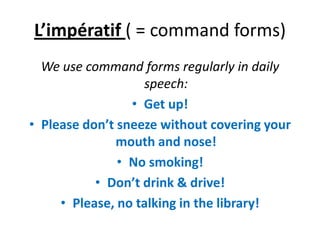
A2 r4798554m limpratifcommandforms
- 1. L’impératif ( = command forms) We use command forms regularly in daily speech: • Get up! • Please don’t sneeze without covering your mouth and nose! • No smoking! • Don’t drink & drive! • Please, no talking in the library!
- 2. L’impératif en français: Commands can be both POSITIVE & NEGATIVE There are THREE forms of + and - commands: + 1) TU: Parle en français s’il te plaît! 2) VOUS: Asseyez-vous! 3) NOUS: Allons-y! - 1) TU: Ne parle pas en anglais! 2) VOUS: Ne commencez pas tout de suite! 3) NOUS: Ne faisons pas de bruit!
- 3. How do we form commands in French? As a general rule, take the TU, VOUS and NOUS forms of the verb: (***BUT*** with the TU form of –ER verbs, remove the –S first!) (EX: PARLER --- Parle! Parlez! Parlons!) To make them negative, just sandwich them between NE--- PAS (EX: PARLER --- Ne parle pas! Ne parlez pas! Ne parlons pas!)
- 4. What do we do with REFLEXIVE VERBS? There are different things depending on whether the command form is POSITIVE or NEGATIVE: POSITIVE: With Reflexive Verbs we INVERT the verb form and the REFLEXIVE PRONOUN (***also the reflexive Pronoun TE becomes: TOI***) (Ex: S’ASSEOIR = to sit down Assieds-toi! Asseyez-vous! Asseyons-nous! NEGATIVE: we keep them exactly the same but just surround them with NE—PAS (Ex: SE LEVER = to stand/get up Ne te lève pas! Ne vous levez pas! Ne nous levons pas!
- 5. ***Irregulars*** As this is French, there are ALWAYS irregulars!! TU NOUS VOUS AVOIR: Aie! Ayons! Ayez! = have ÊTRE: Sois! Soyons! Soyez! = be SAVOIR: Sache! Sachons! Sachez! = know VOULOIR: Veuille! Veuillons! Veuillez! = want
- 6. What to do with PRONOUNS… (+) Positive commands (-) Negative commands These are put AT THE These go BEFORE the END of the command command form and are form and attached to it inside the NE…PAS with a hyphen sandwich MANGER LA PIZZA: MANGER LA PIZZA: Mange-la! (tu) Ne la mange pas! (tu) Mangeons-la! (nous) Ne la mangeons pas! Mangez-la! (vous) (nous) Ne la mangez pas! (vous)
- 7. What to do with Pronouns in (+) commands: • In (+) commands, pronouns FOLLOW the verb form and are attached to it and each other with hyphens • NOTE: LE, LA, LES go before ME, TE, NOUS, VOUS, LUI, LEUR and ALL go before EN • ALL commands ending in a VOWEL, MUST add –S when followed by Y or EN *** ME becomes MOI and TE becomes TOI*** Examples: Donne la pomme à moi ---Donne-la-moi! (=Give the apple to me --- Give it to me!) Va au parc! ---Vas-y! (Go to the park! --- Go there!)